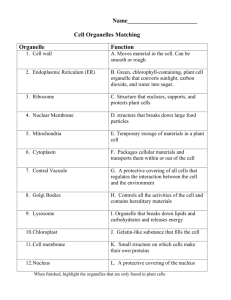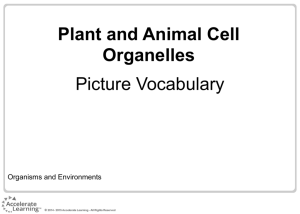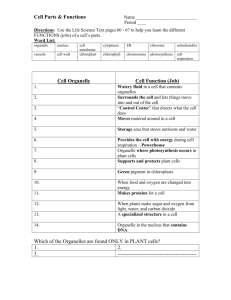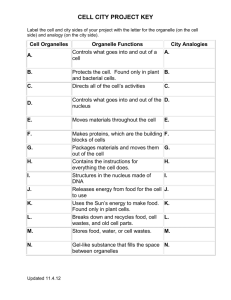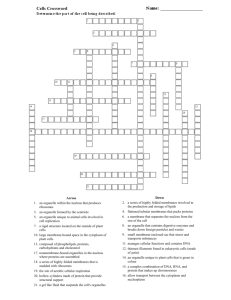Chapter 7
advertisement
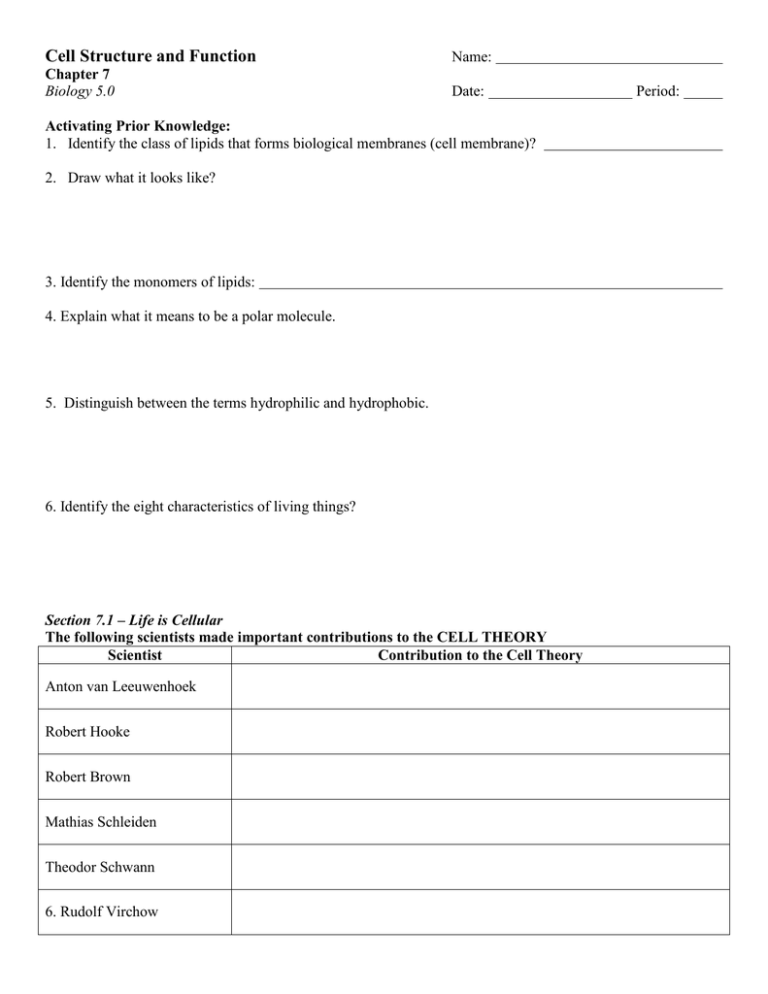
Cell Structure and Function Name: Chapter 7 Biology 5.0 Date: Activating Prior Knowledge: 1. Identify the class of lipids that forms biological membranes (cell membrane)? 2. Draw what it looks like? 3. Identify the monomers of lipids: 4. Explain what it means to be a polar molecule. 5. Distinguish between the terms hydrophilic and hydrophobic. 6. Identify the eight characteristics of living things? Section 7.1 – Life is Cellular The following scientists made important contributions to the CELL THEORY Scientist Contribution to the Cell Theory Anton van Leeuwenhoek Robert Hooke Robert Brown Mathias Schleiden Theodor Schwann 6. Rudolf Virchow Period: The three parts of the Cell Theory: 1. _______________________________________________________________________________________ 2. _______________________________________________________________________________________ 3. _______________________________________________________________________________________ Prokaryote cell Eukaryotic cells pro = ____________________________ karyon = _________________________ contain cell membranes and cytoplasm but no ________________ ____________ is scattered through ____________________ examples: eu = ____________________________ karyon = ________________________ contain a _____________ that holds ____________ membrane bound _________________ that have specific _________________ examples: 1. 1. 2. 2. 3. 3. Definition Description Differences Section 7.2 – Cell Structure What is an Organelle? ORGANELLES Organelle Illustration Organelle Organelle Description & Function Found: between the __________ and the ___________________ Cytoplasm Structure: Function: Found: in the cytoplasm near _____________________________ Structure: filled with ___________________________________ Nucleus Function: Prokaryotic cells lack a nucleus, but they do contain DNA Chromatin Chromosomes a complex of __________________________________________ Chromatin __________________and become densely ________________ Chromosomes are visible under a microscope when a cell divides Nucleolus small dense region within the ______________ where ________________________ are synthesized Nuclear Envelope _____________ membrane (_________________) that surrounds the ______________ -allows materials to move out of the nucleus Nuclear Pore Found: Structure: Vacuole Plant cells, there is a single large central vacuole filled with fluid - can occupy up to 90% of the cell’s volume Animal cells – much smaller Function: Organelle Illustration Organelle Lysosome Organelle Description & Function Found: In the ______________________________ Structure: ___________________________________________ Function: Breakdown large ___________________ molecules, and old _________________________ organelles Removes “junk” that would clutter the cell Known as the “__________________________________” Found in __________ cells and specialized ________ cells Some humans have diseases that result from lysosomes that fail to function properly. Found: Structure: Cytoskeleton Function: Gives cells ________________; helps to maintain _________________; involved in cell ______________________ Microfilaments Microtubules Thin threads made of ______________ (structural protein) ________________________ the cell Contribute to ____________________________ Larger strands; hollow tubes made of __________________ Maintain cell _____________________ Important in ______________________ – forms the mitotic spindle which helps to separate chromosomes Form __________________ in animal cells Help build____________ and __________________ Found: Within the ______________ only in ____________ cells Centrioles Structure: Made of a _________________________ (tubulin) Function: Used to organize _______________________ (mitosis) Cilia Flagella Organelle Illustration Organelle Organelle Description & Function Found: Structure: Ribosomes Function: Produce _____________________ by following coded instructions that come from ________________ Made of ____________ and ______________ in the ______________ & transported to the ________________ Found: just outside the ______________________ Structure: system of membranous tubules & sacs Endoplasmic Reticulum Function: Moves molecules from one part of the cell to another _______________________ Highway Rough ER: Smooth ER Found: in the ________________________ Structure: Golgi Apparatus Function: Works with the ER Modifies proteins for export Found: in the __________________________ Mitochondria Function: Convert ______________________ stored in __________ into compounds that the cell can use “______________________” the cell Most numerous in cells with ________________________ __________________________ liver & muscle Found: Only in the cytoplasm of __________________ cells Structure: Stack of membranes that contain _________________ ________________________(chlorophyll) Chloroplast Function: Surrounded by two membranes and contain DNA Contains the green pigment _______________________ Found: Structure: Cell Wall Function: Found only in _____________________ cells Found: Located around the perimeter of the cell Cell Membrane Structure: Function: ___________________________ permeable Fluid Mosaic Model: Phospholipid Integral Protein Peripheral Protein PLANT Cell Diagram - Use the following organelles to label the PLANT cell below: Cell Membrane Cell Wall Chloroplast Cytoplasm Golgi Apparatus Mitochondria Nuclear Envelope Nucleolus Nucleus Plastid Ribosome Rough ER Smooth ER Vacuole ANIMAL Cell Diagram - Use the following organelles to label the ANIMAL cell below: Cell Membrane Centriole Cytoplasm Golgi Apparatus Lysosome Mitochondria Nuclear Envelope Nucleolus Nucleus Ribosome Rough ER Smooth ER Vacuole Section 7.4: Homeostasis and Cells Levels of Multicellular Organization: Level of Organization simplest most complex Description Examples



